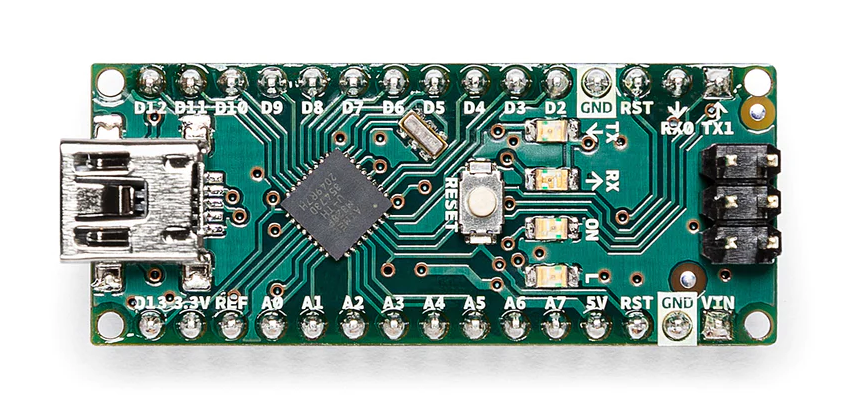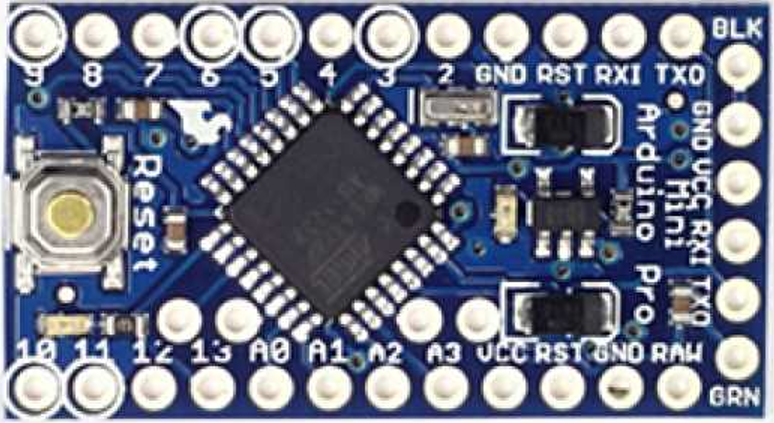Arduino Nano
The Arduino Nano is a microcontroller board launched by Arduino that uses ATmega328p as a microcontroller. It consists of 14 digital input or output pins with a built-in LED pin that is pin 13. Six can also be used as Pulse Width Modulation (PWM) pins. It is mostly used in prototyping, educational projects, robotics, and the Internet of Things (IoT).
Arduino Nano features list:
- The Nano is based on the ATmega328P microcontroller.
- It has 14 digital I/O pins and 8 analog input pins.
- It has 6 PWM pins.
- The I/O voltage is 5V and the input voltage (nominal) is 7-12V.
- The DC per I/O pin is 20 mA.
Arduino Mini
Arduino Mini is a microcontroller board that uses an ATmega328p or ATmega168p with fourteen digital input or output pins. Six of which are Pulse Width modulation pins. It has two versions; one operates on 3.3V and the other can be operated on 5V. It is mostly used in game consoles, robotics, and automation.
Arduino Mini feature list:
- It contains the microcontroller ATmega328P
- Board Power Supply: 3.35 – 12V (3.3V model) or 5 – 12V (5V model)
- Circuit Operating Voltage: 3.3V or 5V (depending on model)
- It has 14 digital I/O pins
- It contains 6 PWM pins.
- It has 1 UART, 1 SPI, and 1 I2C interface available
- Total of 6 analog input pins
- DC Current per I/O Pin: 40 mA
Difference Between Arduino Nano and Arduino Mini
Arduino Nano and Arduino Mini mainly differ in size. The distinguishing features of Arduino Nano and Arduino Mini are explained below in a table.
| Specification | Arduino Nano | Arduino Mini |
|---|---|---|
| Size | Arduino Nano is larger in size than Arduino Mini. It has dimensions of 45 mm x 18 mm. Therefore, it is more suitable for medium size projects. | Arduino Mini is smaller in size than Arduino Nano. It has dimensions of 33 mm x 18 mm Therefore; it is highly suitable for mini or smaller projects. |
| Microcontroller | Arduino Nano uses an ATmega328p microcontroller. | Arduino Mini uses ATmega168p and ATmega328p microcontrollers. |
| Input Voltage and Operating Voltage | Arduino Nano starts with 3.3V or 5V DC, whereas it operates on 7V to 12V DC. | Arduino Mini starts with 5V DC, whereas it operates on 7V to 9V DC. |
| Memory | Static Random Access Memory (SRAM) of Arduino Nano is 2 KB, whereas its Flash memory is 32 KB. | Static Random Access Memory (SRAM) of Arduino Mini is 1-2 KB, whereas its Flash memory is 16 KB or 32 KB. |
| RESET Button | Arduino Nano has a RESET button that erases all programs from the microcontroller. | Arduino Mini does not have a RESET button. |
| Power Consumption | Its power consumption is greater than Arduino Mini because it has USB support on it. | It has low power consumption because it uses an external USB port. |
| USB support | Arduino Nano offers USB support on the board. | It does not have USB support. It uses an external USB port. |
Conclusion
Arduino Nano and Arduino Mini both are very useful microcontroller boards. Both of them have fourteen Digital Input or Output pins and six Pulse Width Modulation pins. They have diverse applications in control systems, embedded systems, electrical engineering projects, and instrumentation.


